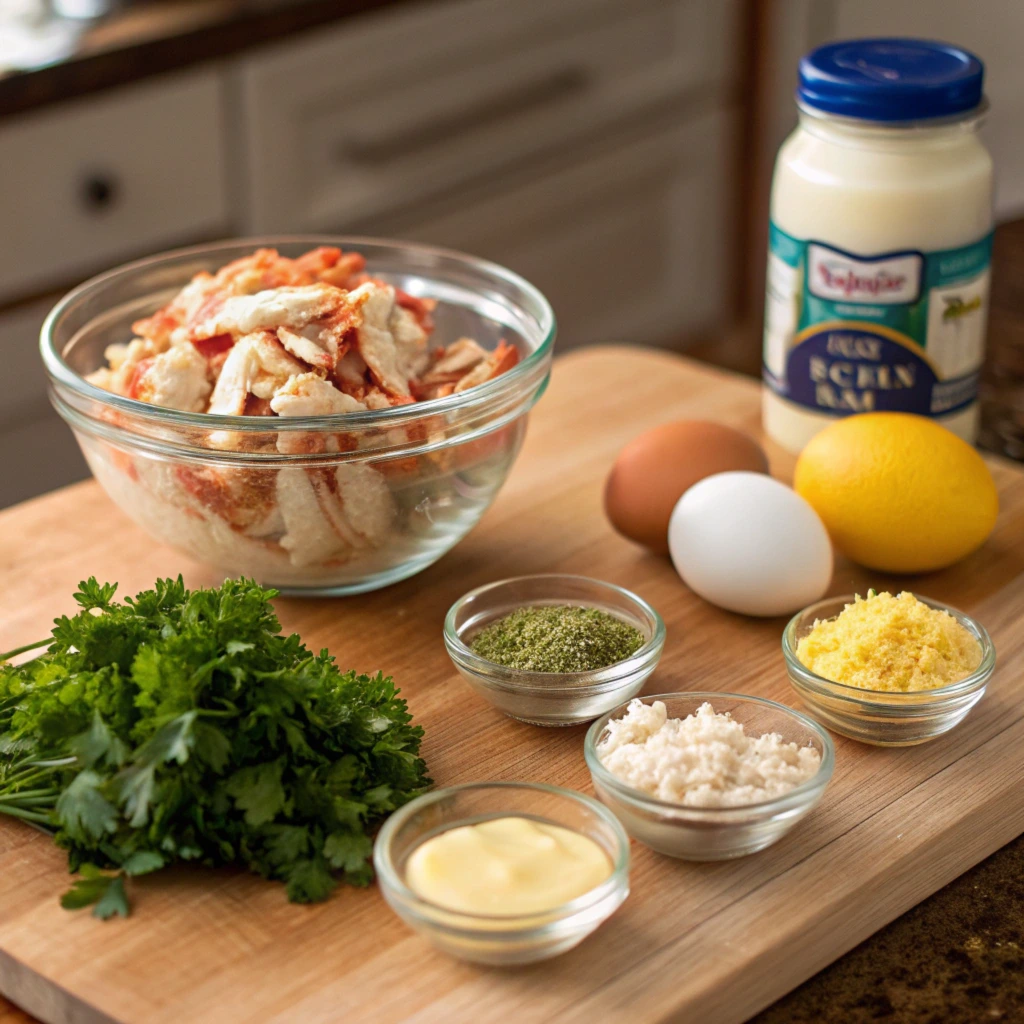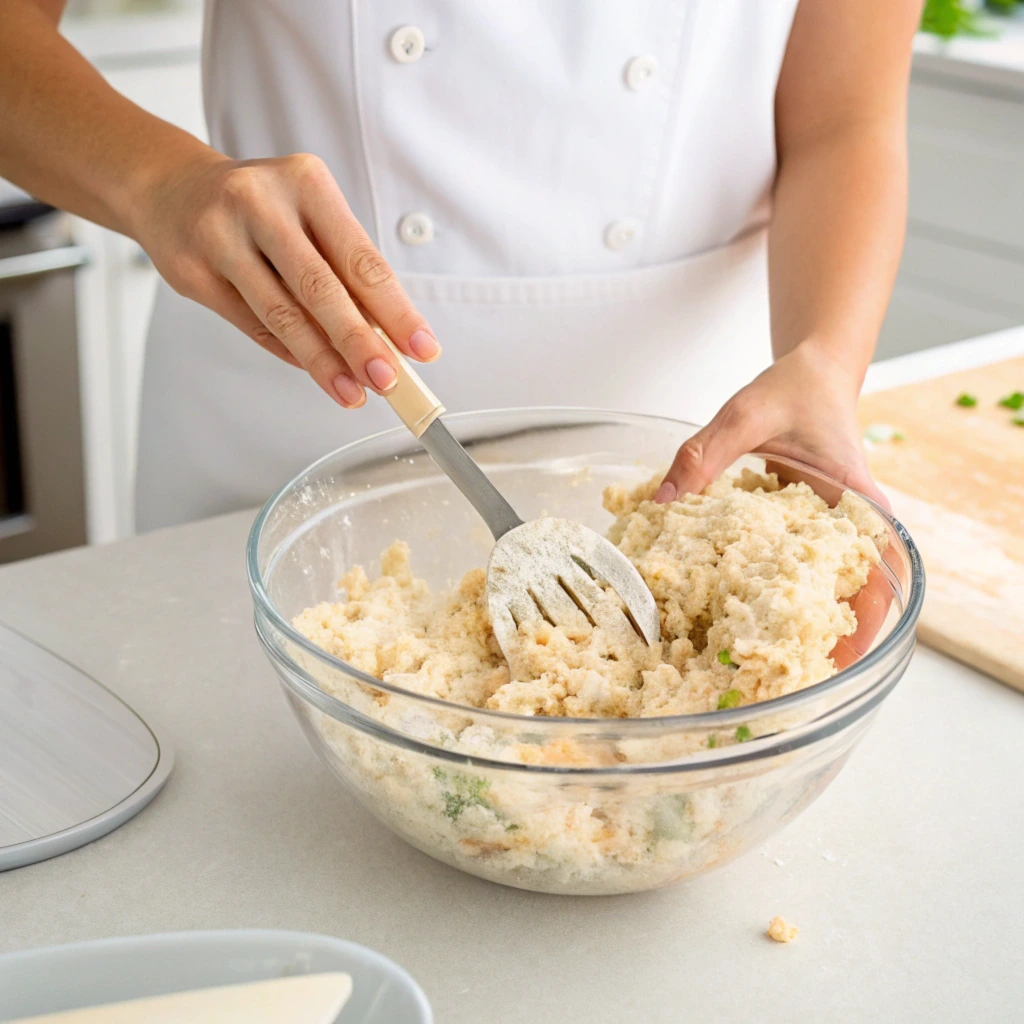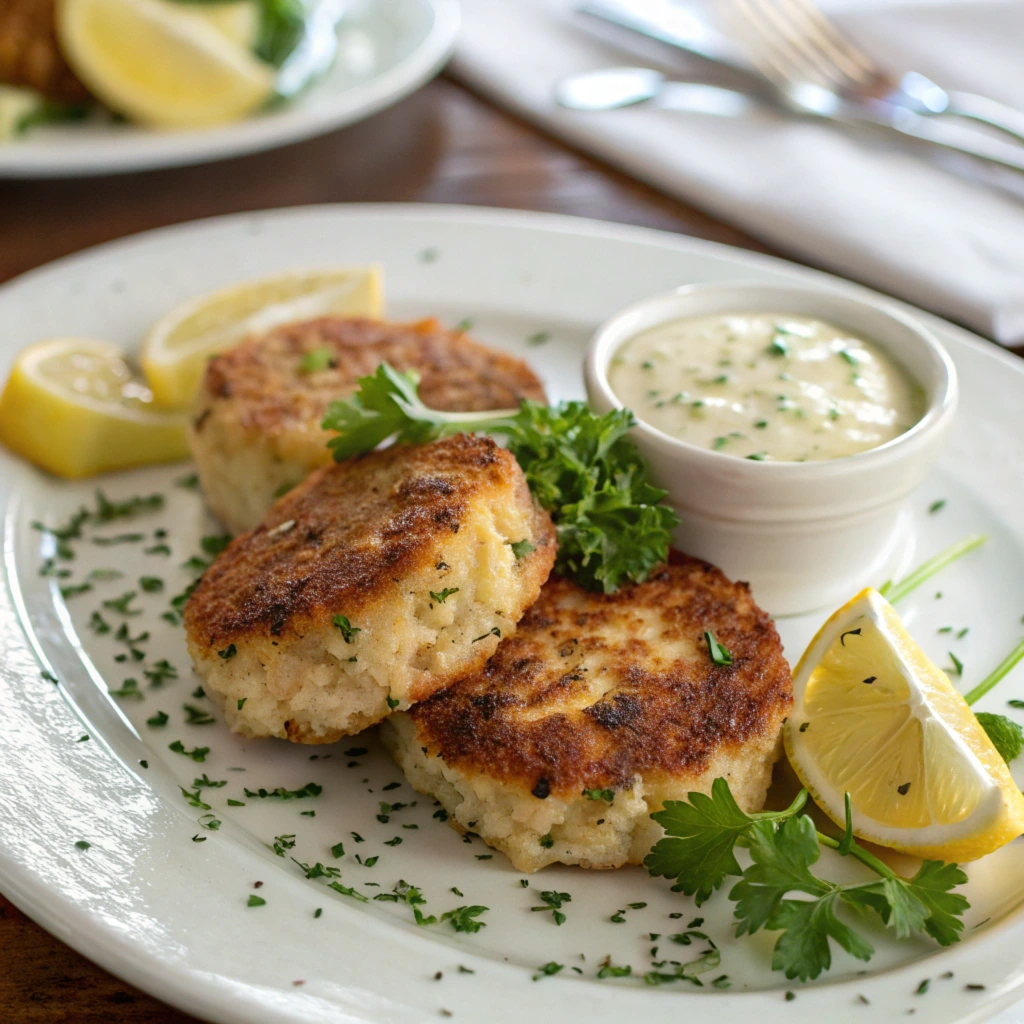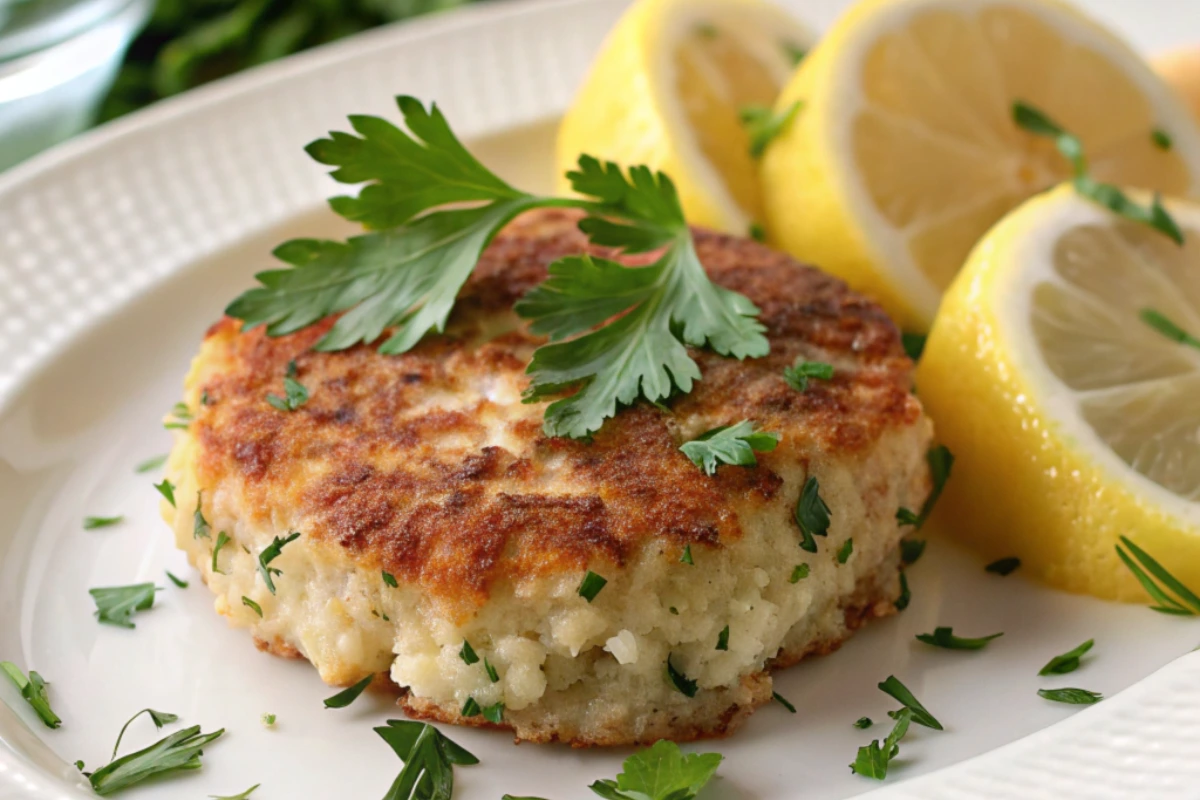Crab cakes are a timeless seafood favorite, but what makes crab cakes stick together is the real secret to their success. Achieving the perfect texture involves balancing fresh crab meat with the right binders and techniques to create cakes that are both flavorful and structurally sound.
Introduction to Crab Cakes
What Are Crab Cakes?
Crab cakes are a quintessential seafood dish with roots in coastal cuisines, particularly along the Eastern Seaboard of the United States. They are usually made from a mix of fresh crab meat, binding agents like eggs, breadcrumbs, or mayonnaise, and a dash of seasoning to enhance the flavor. Whether fried, baked, or broiled, crab cakes are prized for their versatility and melt-in-your-mouth tenderness.
The Key Role of Texture and Consistency in Crab Cakes
Achieving the right texture in crab cakes is a balancing act. The ideal crab cake is flaky and moist on the inside, with a crisp, golden exterior. But here’s the catch: the wrong proportions or techniques can leave you with cakes that either crumble or feel too dense. The binding ingredients, such as eggs and breadcrumbs play a critical role in ensuring that everything holds together, while the mixing process determines whether the crab cakes maintain their delicate structure. It’s all about finding that sweet spot between firmness and lightness.
Essential Ingredients for Binding Crab Cakes

Primary Binding Agents: Eggs and Mayonnaise
When it comes to making crab cakes stick together, eggs and mayonnaise are the go-to binding agents. Eggs act as a natural adhesive, holding all the ingredients in place without overpowering the flavor. Meanwhile, mayonnaise adds moisture and creaminess, which is essential for achieving that perfect texture. A general rule of thumb is to use one egg for every pound of crab meat. Adding just the right amount ensures the mixture is cohesive yet not overly wet.
Role of Breadcrumbs and Alternatives
Breadcrumbs are another key ingredient that helps crab cakes maintain their structure. They soak up excess moisture while providing a subtle firmness. Traditional breadcrumbs work well, but alternatives like panko or crushed crackers can add a unique twist to the texture. For those seeking a gluten-free option, almond flour or mashed potatoes are excellent substitutes. The key is to strike a balance, too much filler can overshadow the delicate flavor of the crab.
How Fresh Crab Impacts the Texture
Using fresh, high-quality crab meat is essential not just for flavor but also for consistency. Fresh crab meat tends to have a firmer texture, which makes it easier to bind. Avoid over-shredding the meat during preparation, as larger chunks create a more stable structure and enhance the visual appeal of your crab cakes. Remember, the crab is the star of the show, so handle it with care!
Techniques for Achieving the Perfect Consistency
Mixing Techniques to Avoid Overworking
The way you mix your ingredients can make or break your crab cakes, literally! Overmixing can cause the mixture to become too dense, making it harder to hold together. Instead, gently fold the ingredients using a spatula, ensuring everything is evenly distributed without breaking down the crab meat. This method preserves the delicate, flaky texture that makes crab cakes irresistible.
The Right Ratio of Ingredients for Firmness
Finding the perfect ratio of crab to binders is critical. Aim for a ratio of about 80% crab meat to 20% binding agents and fillers. This ensures that the crab flavor remains prominent while providing enough structure for the cakes to hold their shape. A mixture that’s too dry may crumble, while one that’s too wet will fall apart during cooking. Adjust the proportions as needed to achieve a cohesive mixture.
Chilling the Mixture Before Cooking
One often-overlooked technique for making crab cakes stick together is chilling the mixture. Once everything is combined, let the mixture rest in the refrigerator for at least 30 minutes. This step allows the ingredients to firm up and makes shaping the cakes much easier. Plus, it helps the flavors meld together, enhancing the overall taste of the dish. Whether you’re frying, baking, or broiling, chilled crab cakes hold up better during cooking.

Common Problems and How to Fix Them
Why Do Crab Cakes Fall Apart?
One of the most frustrating challenges in making crab cakes is when they fall apart during cooking. The primary culprit is often an imbalance in the binding agents. Without enough eggs or breadcrumbs, the mixture may lack the necessary cohesion. Additionally, using overly wet crab meat or skipping the chilling process can weaken the structural integrity of the cakes. To troubleshoot, ensure the mixture is moist but firm, and always refrigerate before shaping and cooking.
For more insights into cooking techniques, check out “Is it better to fry or bake crab cakes?”.
Adjusting Ingredients for Optimal Stickiness
Tweaking the recipe is sometimes necessary to achieve perfect consistency. Start by gradually increasing the binder, whether it’s eggs, mayonnaise, or breadcrumbs, until the mixture holds together without being overly dense. If the cakes feel too wet, try adding a small amount of dry filler, like crushed crackers, a spoonful at a time, until the desired firmness is achieved.
Cooking Tips to Maintain Structure
Even if your crab cakes are well-formed, poor cooking techniques can cause them to crumble. Always preheat the pan or oven to ensure even cooking. Use a gentle touch when flipping crab cakes to prevent breakage. A non-stick surface or a light coating of oil can also help keep the cakes intact during frying or baking.
Creative Variations for Binding Crab Cakes
Using Gluten-Free Ingredients
For those with dietary restrictions, there are plenty of creative ways to make crab cakes stick together without traditional breadcrumbs. Substitutes like almond flour, coconut flour, or crushed gluten-free crackers can work wonders. These alternatives not only provide a unique flavor but also maintain the integrity of the cakes. Plus, they pair well with lighter, healthier versions of crab cakes.
Innovative Additions for Extra Stickiness
If you’re feeling adventurous, try incorporating mashed sweet potatoes or a dollop of cream cheese into your mixture. These ingredients not only act as binders but also add a rich depth of flavor. Another surprising yet effective option is finely chopped cooked quinoa, it’s packed with protein and has a naturally sticky texture.
For inspiration on unique seafood creations, take a look at “What are crab balls made of?”.
Adapting Recipes for Dietary Restrictions
Beyond gluten-free options, you can tailor crab cake recipes to fit other dietary needs. For egg-free versions, try using flaxseed meal mixed with water or aquafaba as a binding agent. Dairy-free crab cakes can be made using plant-based mayonnaise. These adjustments allow everyone to enjoy delicious crab cakes, regardless of dietary preferences.
FAQs on Crab Cakes
What Is the Best Binder for Crab Cakes?
The best binder for crab cakes depends on your recipe and dietary preferences. Eggs are the most common and effective choice, as they naturally hold ingredients together without compromising flavor. Mayonnaise is another excellent option, adding both moisture and a creamy texture. If you’re looking for alternatives, mashed potatoes, cream cheese, or even finely blended oats can do the trick. The key is to choose a binder that complements the flavor of the crab without overpowering it.
Can You Make Crab Cakes Without Breadcrumbs?
Absolutely! While breadcrumbs are a traditional filler, there are plenty of substitutes for those who prefer a breadcrumb-free version. Crushed crackers, panko, or even cooked quinoa can provide the same structure. For a gluten-free alternative, almond flour or mashed sweet potatoes work beautifully. These options maintain the integrity of the crab cakes while catering to specific dietary needs.
How Do You Keep Crab Cakes from Falling Apart When Frying?
Keeping crab cakes intact while frying starts with a well-prepared mixture. Use just enough binder to hold the crab meat together and avoid overmixing, which can weaken the structure. Chilling the mixture before shaping is crucial, as it firms up the cakes and makes them easier to handle. When frying, use medium heat and flip gently with a spatula to prevent breakage. And remember, a non-stick skillet or a light coating of oil can make all the difference.
Conclusion and Expert Tips

Summary of Key Techniques for Perfect Crab Cakes
Creating crab cakes that hold together while staying flaky is all about balance. Start with fresh, high-quality crab meat for flavor and pair it with binding agents like eggs or breadcrumbs for structure. Always chill the mixture before cooking to firm it up and prevent crumbling. Handle the mixture gently to avoid overworking it, which can make the cakes dense. Lastly, whether frying, baking, or broiling, use medium heat and flip carefully to achieve a golden-brown crust. These simple steps ensure delicious and sturdy crab cakes every time.
Top Tips for Consistency and Flavor
Let’s dig deeper into what makes the best crab cakes unforgettable. First, the flavor of the crab meat should always take center stage. Minimize the use of fillers and seasonings to let the natural sweetness of the crab shine. A splash of fresh lemon juice, a sprinkle of Old Bay seasoning, or a handful of finely chopped parsley can elevate the dish without overpowering it.
For consistency, sticking to an 80:20 ratio of crab meat to binders and fillers is a tried-and-true formula. This balance creates a mixture that’s firm enough to hold its shape but light enough to maintain the delicate texture of the crab.
Experimentation is another avenue to elevate your crab cakes. Try adding a hint of Dijon mustard for a tangy kick, or substitute panko breadcrumbs with crushed saltines for a nostalgic touch. For a healthier twist, consider baking instead of frying. Baking provides a crisp outer layer without the extra oil, making it an excellent choice for lighter meals.
Additional Expert Insights for Perfecting Crab Cakes
Did you know that the type of crab meat you use can impact the texture and flavor? Lump crab meat works best for crab cakes, as it has large, tender pieces that hold together better. If lump crab isn’t available, jumbo lump or claw meat are excellent alternatives, each offering their own unique flavor profiles. Whichever you choose, make sure the crab meat is fresh and free of excess moisture, as this can affect both taste and structure.
Another expert tip is to let your crab cakes rest after shaping. Allowing them to sit for 10–15 minutes before cooking helps the ingredients bind further, reducing the risk of crumbling. Plus, this step allows the flavors to meld together for a more cohesive and delicious bite.
Elevate Your Crab Cakes with Sauce Pairings
Pairing crab cakes with the right sauce can take them from good to extraordinary. Classic tartar sauce is a favorite, offering a tangy contrast to the rich crab. Remoulade, a zesty mayonnaise-based sauce, adds an extra layer of flavor. For a lighter option, a simple lemon aioli or a yogurt-based herb sauce can provide a refreshing balance. Don’t be afraid to get creative, spicy sriracha mayo or a drizzle of garlic butter can add a unique twist.
Final Thoughts on Making Perfect Crab Cakes
Making crab cakes that stick together requires a mix of science and creativity. By focusing on the fundamentals, high-quality crab meat, effective binders, proper chilling, and careful cooking, you’ll create a dish that’s as visually stunning as it is delicious. Whether you stick to tradition or venture into innovative variations, the secret lies in understanding the balance of flavors and textures. Remember, practice makes perfect, and with these tips in hand, you’re well on your way to mastering the art of crab cakes.
For more seafood recipes and tips, be sure to explore other articles, like “Is it better to fry or bake crab cakes?”.

